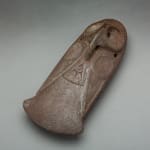Taino Stone Bird Celt, 1200 CE - 1500 CE
Stone
4.5 x 10.2
LR.034
Further images
The Taino Stone Bird Celt, dating between 1200 CE and 1500 CE, is a significant artifact from the indigenous Taino culture of the Caribbean. Crafted from stone, this celt—a tool...
The Taino Stone Bird Celt, dating between 1200 CE and 1500 CE, is a significant artifact from the indigenous Taino culture of the Caribbean. Crafted from stone, this celt—a tool typically used for chopping or ceremonial purposes—features a bird motif, a common theme in Taino art symbolizing spiritual connection and communication with the divine. The Taino were an advanced pre-Columbian society inhabiting the islands of the Greater Antilles, including what is now Cuba, Hispaniola, Puerto Rico, and Jamaica. This particular object not only reflects their skilled craftsmanship but also their deep connection to nature and spiritual beliefs.
The bird representation on the celt likely held profound symbolic meaning. Birds were seen as messengers between the human world and the spiritual realm, often associated with deities or ancestral spirits in Taino cosmology. This celt may have been used in religious ceremonies or as a high-status object, possibly owned by a cacique (chief) or shaman. Its dual function as both a practical tool and a ceremonial object underscores the Taino's holistic approach to art and utility, where the sacred and the everyday often intersected.
Physically, the celt is smooth and carefully carved, with the bird's form abstractly rendered. The figure is subtly integrated into the stone’s natural shape, with minimal yet purposeful detailing. The curves and contours of the object suggest both strength and grace, qualities that would have been important in its use and symbolic function. Its dimensions—4.5 x 10.2 inches—make it a relatively small, handheld piece, yet its artistic and cultural value far exceed its size, serving as a lasting testament to the Taino's skill and spiritual worldview.
The bird representation on the celt likely held profound symbolic meaning. Birds were seen as messengers between the human world and the spiritual realm, often associated with deities or ancestral spirits in Taino cosmology. This celt may have been used in religious ceremonies or as a high-status object, possibly owned by a cacique (chief) or shaman. Its dual function as both a practical tool and a ceremonial object underscores the Taino's holistic approach to art and utility, where the sacred and the everyday often intersected.
Physically, the celt is smooth and carefully carved, with the bird's form abstractly rendered. The figure is subtly integrated into the stone’s natural shape, with minimal yet purposeful detailing. The curves and contours of the object suggest both strength and grace, qualities that would have been important in its use and symbolic function. Its dimensions—4.5 x 10.2 inches—make it a relatively small, handheld piece, yet its artistic and cultural value far exceed its size, serving as a lasting testament to the Taino's skill and spiritual worldview.











